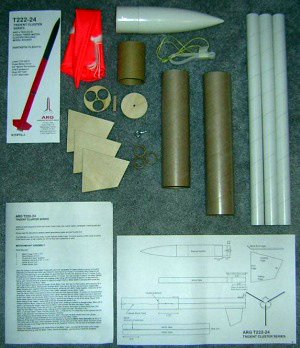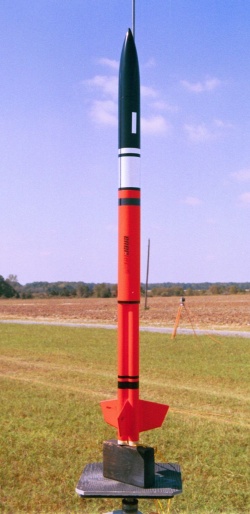Advanced Rocketry Group Ltd. Trident 222-24
Advanced Rocketry Group - Trident 222-24 {Kit}
Contributed by Steve Naquin
| Construction Rating: | starstarstarstarstar |
| Flight Rating: | starstarstarstarstar |
| Overall Rating: | starstarstarstarstar |
| Manufacturer: | Advanced Rocketry Group |

Brief:
ARG Rockets Trident Cluster Series "D or E" rocket with payload
section manufactured by Taras Tataryn of Advanced Rocketry Group Ltd. in
Mississauga, Ontario, Canada. This kit features a 3 x 24mm motor mount with
wedge fin attachment. Recovery of this rocket is by a high visibility 24"
rip stop nylon parachute.
Construction:
Taras was kind enough to ship the kit to me from NARAM 47 well packaged in a
clear plastic bag with a color face card for Kit #TS-3 Trident Cluster Series
rocket. Included are three pages of build instructions and an additional
8" x 14" single page detailed dimensioned assembly drawing to assist
with the placement of some items explained in the build instructions.
The following parts are included with this kit:
- 1 Sustainer Airframe (2.22" x 11")
- 1 Payload Section (2.22" x 9")
- 1 Nose Cone, Foam
- 3 Motor Tubes (1.02" x 17")
- 1 Coupler Tube
- 1 Bulkhead Disk, Plywood
- 1 Screw Eye
- 1 Cluster Bulkhead, Plywood
- 3 Fins, Plywood
- 3 Motor Blocks
- 2 Launch Lugs
- 1 Balsa Launch Lug Stand-off
- 1 Shock Cord, Kevlar®
- 1 Shock Cord, Elastic
- 1 Parachute, 24"

All plywood parts are laser cut. The nose cone is foam with an outer hard shell and is very smooth with no seam lines, lightweight (2.8oz), and easy to finish. The instructions are well written and easy to follow. Additional tools required to finish this model include hobby knife, ruler, pencil, epoxy, sandpaper, masking tape, and spray paint.
Assembly is broken down into four separate assembly steps: motor mount assembly, payload section assembly, fin assembly, and final assembly. The parts required for each of the four steps are listed with that particular steps assembly instructions. This is a well planned method to lay out assembly since you gather only the parts you require for each of the four steps instead of pulling from the entire bag of parts. Also listed within these instructions are the parts list and launching instructions.
The additional 8" x 14" detailed dimensioned drawing outlines coupler/bulkhead, motor block/motor tube, Kevlar® shock cord mounting, fin bevel, and launch lug/stand-off placements for the T222-24. I found this drawing and additional information a nice addition to the kit and very helpful. I kept it handy during all assembly steps to glance at from time to time to assure proper placement of the parts as I went through each of the four construction steps.
I used AeroPoxy ES6220 fast setting liquid epoxy adhesive for the entire build. It has a working time of 4-6 minutes and cures very rapidly.
I used the Kevlar® and elastic shock cord included with the kit. I added a Pratt Hobbies 2,000 degree Aramid cloth heat shield parachute protector to use as permanent flameproof recovery wadding and anchored it to the Kevlar® cord.
Finishing:
The T222-24 was finished with 3 coats of Kilz sealer/primer sprayed only on the
fins to fill in the wood grain. I then sprayed 3 light coats of Krylon gloss
white for a base on the entire lower section and when dry followed up with 3
light coats of Krylon #3101 red/orange fluorescent paint. Krylon gloss black
was used for the payload section and nose cone. I used chrome and black
self-adhesive Monokote cut to size for the additional chrome and black trim
bands.
Phred at Excelsior Rocketry produced an excellent decal sheet from a scan I provided of an EnerJet logo decal sheet that I purchased many years ago from AAA Model Aviation Fuels. Phred recommended in the provided instructions to use Microscale liquid decal film, micro set and micro sol to apply the decals. I used all three of these Microscale products with very good results. These EnerJet logo decals are available for sale from Phred on the Excelsior Rocketry website and are located with the Centuri waterslide decals.


Construction Rating: 5 out of 5

Flight:
First flight was at the Tripoli Louisiana "High Cotton" launch on
Saturday October 22, 2005. I used 3 D12-5 motors with masking tape for a
friction fit into the motor tubes and used Quickburst "Poppers"
electric matches for ignition. Instant cluster motor ignition with a very
straight, fast boost to an estimated apogee of 1,150 feet.
Flight Rating: 5 out of 5
Summary:
This is a very nice kit based on the EnerJet 2250 sounding rocket originally
produced in 1972 and designed by Larry Brown for EnerJet. The original EnerJet
2250 by design used a cluster of three 29mm motor mounts.
Several upgrades in the ARG kit, such as Kevlar® shock cord, hard foam nose cone, and laser cut plywood parts, are welcomed improvements to the original design. Fans of the early EnerJet sounding rockets will appreciate building this rocket to experience the early high power rocketry design and construction techniques that were used back in the early 1970's including wedge fin attachment and clustered motor flights. U.S. Rockets and LOC/Precision also still use this wedge fin attachment design in some of their current kits and I find it interesting that over three decades later it's still an efficient and proven construction technique used today in current HPR kit construction.
ARG has also released the Trident T172-stretch that flys on 3x18mm motors and will soon release the T172-18 and the T263-29 kit for 3x29mm motors.
All-in-all this kit is a good value as priced and a unique and rewarding rocket that you will be proud to display and fly at your next launch. My thanks to Taras Tataryn for the historical EnerJet images and data he provided.
Overall Rating: 5 out of 5
 |
 |
Flights
 |
 |
C.H. (January 18, 2007)
 |
 |
K.G. (January 2, 2007)